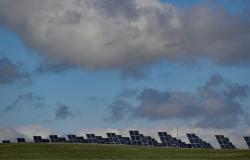Hear
“The extreme right advances”. This phrase is repeated a lot throughout Europe at the moment. “This looks like Europe in the 1930s.” So perhaps it is not surprising that the 350 million people living in the European Union, who are called to the polls this weekend, are making many Eurocrats in Brussels bite their nails. Are fears and media headlines exaggerated?
It is expected that the millennials and first-time voters of Generation Z are the age group most inclined to vote for right-wing parties. The figures recently compiled by the newspaper Financial Times suggest that around a third of young French and Dutch voters under 25, and 22% of young German voters, lean towards the extreme right of their country. This is a significant increase since the last European Parliament elections in 2019.
It is likely that the parties of extreme right obtain up to a quarter of the total seats and, if they achieve a big victory, the picture will begin to become clearer. But the impact this could have on life and policymaking in the EU is more nuanced. And that is because the nationalist right itself has its own spectrum: different politicians from nationalist right in different countries maintain different positions. Some have toned down old far-right rhetoric to try to broaden its appeal to voters.
So what could change in Europe if the European Parliament shifts to the right?
The European Union (EU) has long nurtured an enormous ambition: to be ahead of the rest of the world when it comes to the environment. But European voters are increasingly concerned about the cost of an energy transition.
Taking the recent massive farmers protests as an example: tractors from all over the EU swarmed Brussels and the European Parliament, bringing them to a standstill. The protesters said that EU national environmental laws and bureaucracy were putting them out of business.
Nationalist right-wing parties in France, the Netherlands and Poland jumped on this bandwagon, seeing an opportunity to present their claim to be representatives of the “common people” against the “disconnected elites” national and European Union. The result? The EU repealed or rescinded several key environmental rules, including stricter regulations on pesticide use.
Environmentalists are concerned that the EU has avoided specifying what the farmers’ contribution to the goal of reducing 90% of emissions by 2040. They believe that a shift to the right in the European Parliament could mean further dilution or endless delay of the green goals.
Most of the European voters say they do not want to leave the EU, although they have many complaints about how it works. Instead, right-wing nationalist parties promise a different EU: more power for the nation states and less “Brussels interference” in daily life.
If its voice becomes stronger in the European Parliament, it could be more difficult for the European Commission to take over more powers from national governments, such as health policies.
You would think that this would be obvious and that a shift to the right in the European Parliament would lead to a Stricter EU migration legislation. The far-right leader in the Netherlands, Geert Wilders of the PVV party, became the largest group in the Dutch parliament this fall after the national elections.
He promised to launch “the toughest immigration law of all time” and exit polls suggest that the PVV will do well in these elections. But it is worth bearing in mind that the EU’s migration and asylum policy has long been nicknamed the “Fortress”.
One of the main goals is to keep people out. There has been a avalanche of economic agreements with non-EU countries such as Tunisia, Morocco, Libya and Türkiye to crack down on human traffickers who send economic migrants or asylum seekers.
However, what a larger far-right group in the European Parliament could change are the so-called solidarity policies. Each EU country is supposed to accept a quota of asylum seekers or at least pay significant contributions to help other members from the EU such as Italy and Greece, where most migrants arrive on human smugglers’ boats.
But nationalist right-wing MEPs may refuse to cooperate, as was already seen with populist nationalist governments in Hungary and, until recently, Poland.
The Russian invasion of Ukraine prompted leaders across the EU to talk about how to make their “neighborhood” safer. Not only spending more on defense but accelerating the process – or at least showing more concrete enthusiasm – for neighboring countries to join the EU. That is to say, Ukraine, Georgia and the Balkan nations Western countries such as Kosovo and Serbia. The latter is of great concern to Europeans due to its proximity to Moscow.
But the nationalist right in general is not very interested in that issue. They fear the costs of expansion. A Larger EU, with more poorer countries in it, would probably need a bigger budgetwith larger contributions from comparatively richer member states.
It would also mean that bloc members that received considerable EU subsidies, such as Romania, Poland and also French farmers (who remain the single largest beneficiary of the EU’s Common Agricultural Policy), would likely stop benefiting.
It is not difficult to imagine what would happen to them if the huge agricultural Ukraine– largely rural and dubbed the breadbasket of Europe – would join the EU, for example.
Security and defense tend to be seen as workhorses of the right, but in these days of conflict, most in the EU agree that spending on defense is a priority. His conviction was reinforced by the prospect of Donald Trump returning to the White House as president of the United States.
Since the Second World War, Europeans They sought the United States to support them in terms of security. Just look at how instrumental Washington has been in providing aid to Ukraine. But Trump was clear that if he wins the presidency in the US elections in November, Europe should take nothing for granted. EU leaders are convinced that they need to be better prepared.
Ukraine is a clear example of why generalizing about the far right as if it were a uniform movement can be very misleading. It is true that far-right parties spread across the EU say they intend to change the bloc from within.
If they win more MEPs this week and if they manage to be part of more national governments, that will give them a bigger voice in the European Parliamentat key meetings of EU ministers and at EU leaders’ summits.
But it is also true that the impact they have on the EU depends on how united those political parties are. Ukraine is an example that they are deeply divided.
Tensions within Italy’s government sum up this picture. Matteo Salvini and his far-right Lega party are in a coalition government with right-wing nationalist Prime Minister Giorgia Meloni of the Brothers of Italy group.
Meloni is an avowed Atlanticist who has promised continued military and economic aid to kyiv. Salvini, on the other hand, is more typical of hard-right nationalists in Europe: somewhat skeptical of the United States, closer to Moscow, like Marine Le Pen’s National Rally party. In the past, Matteo Salvini liked to post photos of his visits to Russia on social media, including one that shows him posing in front of the Kremlin, wearing a T-shirt emblazoned with the image of Vladimir Putin.
Another obstacle to the coordination of European far-right parties is the leadership. The nationalist right tends to favor charismatic and outspoken national leaders, proclaiming “Italy first” or “Make Spain great again” or “France for the French,” depending on which country they come from.
The Italian Georgia Meloni will not want the French Marine Le Pen to tell her why fight in Brussels. Le Pen would be unlikely to accept having her wings clipped by Hungarian Victor Orban, and so on.
Part of the problem here is the terminology. Who are the hard right? How center-right does your political group have to be to be labeled “far right”? Supporters of right-wing nationalism complain that mainstream media and mainstream politicians are quick to use the term.
The Italian Giorgia Meloni is an outstanding example of a former “far right” figure who tried to soften his positions to attract a broader spectrum of voters. If he previously openly praised the former Italian fascist dictator Benito Mussolini, he now cites the former British Prime Minister Margaret Thatcher as an inspiration.
Marine Le Pen tried to erase reputation for racism and anti-Semitism among his followers. And before last year’s Dutch general election, Geert Wilders abandoned the extreme anti-Islam attitude with which critics associated him, to win big.
What further muddies political definitions is that center-right politicians throughout Europe increasingly began to imitate the rhetoric of the “far right” on hot topics like migration or law and order. By doing so, they hope to retain voters who could be targeted by the far right. This was the case with the Prime Minister of the Netherlands, Mark Rutte, for example, and also with the President of France, Emmanuel Macron.
His recent immigration law was only approved in French parliament with the support of the far right. French media debated whether Marine Le Pen had “won”, as she hopes to do in this week’s European parliamentary elections.
BBC World





